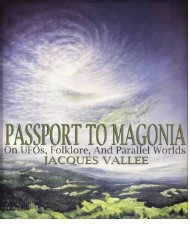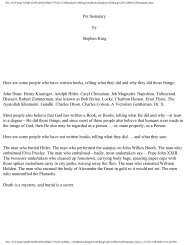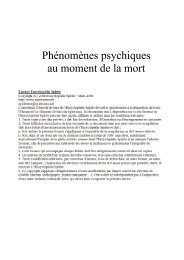extraordinary%20encounters
extraordinary%20encounters
extraordinary%20encounters
You also want an ePaper? Increase the reach of your titles
YUMPU automatically turns print PDFs into web optimized ePapers that Google loves.
Fairies encountered<br />
Traditions of fairy folk can be found anywhere<br />
in the world, but they are usually spoken of in<br />
the past tense. What is less well known is that<br />
such beliefs derive not just from distant folklore<br />
but from perceived experiences of a sort<br />
that are still reported from time to time even<br />
today. British anomalist Janet Bord writes,<br />
“Today the knowledge of and belief in fairies<br />
has all but died out among country<br />
people. . . . However[,] the changes that have<br />
occurred this century have not resulted in the<br />
complete extinction of the fairies: they have<br />
survived, because people still see them” (Bord,<br />
1997). Though Victorian popular culture perpetrated<br />
the notion that fairies are gauzywinged<br />
creatures, the fairies of tradition have<br />
no wings. Beyond that, they vary in appearance<br />
from region to region, though most are<br />
small and humanlike, sometimes with brown<br />
or green skin. They are of uncertain temperament<br />
and, thus, best avoided.<br />
Collectors of folklore—a notion and discipline<br />
that came into existence around 1800—<br />
came upon many firsthand accounts. These<br />
can be found in any number of scholarly texts<br />
on fairy lore. Though sometimes puzzled by<br />
the apparent sincerity of their informants, few<br />
folklorists were willing to take the leap of faith<br />
required to embrace actual belief in fairies.<br />
F<br />
99<br />
One who did, however, was the well-regarded<br />
W. Y. Evans-Wentz, an anthropologist of religion<br />
who had a Ph.D. from Oxford University.<br />
In the first decade of the twentieth century,<br />
Evans-Wentz traveled through the Celtic<br />
regions of the British Isles as well as Brittany<br />
(on France’s northwest coast). The result was a<br />
folklore classic, The Fairy Faith in Celtic<br />
Countries (originally published in 1911).<br />
Aside from its worth as a record of surviving<br />
fairy beliefs and associated superstitions, it is<br />
unique in its championing of an underlying<br />
reality behind the tradition. Like the pioneering<br />
Rev. Robert Kirk, a Scottish clergyman<br />
whose The Secret Common-Wealth (1691) preserved<br />
fairy lore in the Highlands, Evans-<br />
Wentz deduced that fairies live in an otherworld<br />
that overlaps with the human world.<br />
He went so far as to claim that “we can postulate<br />
scientifically, on the showing of the data<br />
of psychical research, the existence of such invisible<br />
intelligences as gods, genii, daemons,<br />
all kinds of true fairies, and disembodied<br />
men.”<br />
Not all purported witnesses were the uneducated<br />
rural folk stereotypically associated<br />
with fairy beliefs and encounters. A seventeenth-century<br />
Swedish clergyman, Peter<br />
Rahm, gave this sworn statement to legal authorities:





